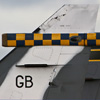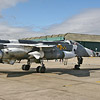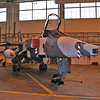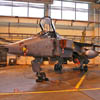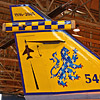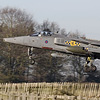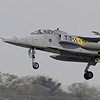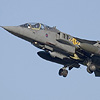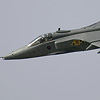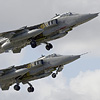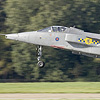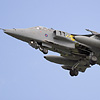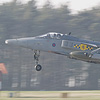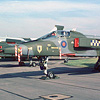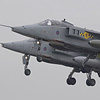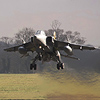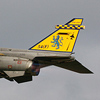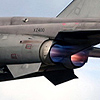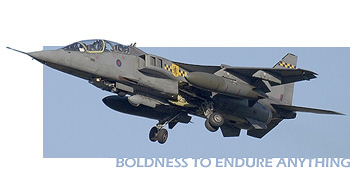
54(F) Squadron History Feature Report
March
Sadly, unlike The Saints of 16(R) Squadron, 54(F) Squadron never got the chance to celebrate their 90th anniversary alongside so many other Squadrons this year, the 87th year of the Royal Air Force. Almost 89 years ago, under the command of Major Horn, and flying BE.2Cs and Avro 504s, 54(F) Squadron began flight operations. Initially, the squadron were tasked with homeland air defence but soon moved to France to play their part in the Great War by escorting bombers and downing observation balloons. During the latter years of the war, the aerial dominance role was supplanted with ground attack missions with Sopwith Camels.
Report by . Additional photography by and .
After moving back to the UK after the war, the Squadron was disbanded in October 1919 - then reformed about ten years later at Hornchurch, again with an air defence tasking. It is from Hornchurch that the Squadron flew their Spitfire Is into combat in defence of the South East of England when war in Europe broke out again. Additionally, the Squadron provided fighter cover for the Dunkirk evacuation and, a few months later, were given the additional task of providing air defence for convoys. Roughly mid-way through the war the Squadron was redeployed to Darwin, Australia from where attacks upon Japanese forces were mounted. 54(F) Squadron, having done pretty much every mission a fighter pilot could imagine, came out of World War II as the top scoring RAF fighter unit - with an impressive haul of 131 confirmed kills. Ninety-seven of these kills were Messerschmitt Bf109s, a formidable opponent flown by many of the high scoring Luftwaffe pilots such as Erich Hartmann and Gerhard Barkhorn who each tallied up more than 300 kills.
After the end of the war, 54(F) Squadron remained in Australia where they were disbanded. However, less than one month later, 183 Squadron at Chilbolton were redesignated as 54(F) Squadron and spent about a year training aircrew for operations overseas. The Squadron then moved to RAF Odiham and took delivery of Vampires and became the first unit to fly them in the demanding night-fighter role. The Brussels International Air Display in July 1947 saw 54(F) Squadron bring along their newly worked up four-ship Vampire team and can lay justifiable claim to being the World’s first ever jet formation aerobatic team. The same team also put on a sensational display, later that same month, at the Grand International Aeronautical Gala at Evere, Belgium.
1948 saw the Squadron again find their way into the record books when, on an annual goodwill visit, they flew six Vampire F.3s across the Atlantic to the USA, making the first transatlantic crossing by jet aircraft. In doing so, the RAF demonstrated the impressive endurance of their Vampires and also managed to beat the USAF who were planning a similar trip to the UK. The six jets left Odiham on 1st July 1948 and returned home on 26th August 1948 after having visited numerous US and Canadian bases. Seven years later the Squadron, now flying Hunters, were instructed that they were to take part in an airshow at Geneva - the "54(F) Squadron Jet Formation Aerobatic Team" name didn’t quite stand up to the inspiring names of the teams also in attendance at Geneva and the team became known as The Black Knights. The team also made history by being the first RAF team to trail smoke by injecting diesel into the jet exhaust.
When they received their Hunters, the Squadron became tasked with a ground attack role in No. 38 Group and often forward deployed to various trouble spots around the world as part of the No. 38 Group ‘Offensive Strike Wing’. 54(F) Squadron and their Hunter FGA.9s saw further combat during the Aden Emergency in the early 1960s when they attacked Egyptian-backed guerilla forces and dissidents in the region’s uprising against British colonial rule. The Squadron was then given it’s Standard in May of 1963 whilst based at West Raynham, after having previously seen time at Stradishall and Waterbeach.
During 1969, 54(F) Squadron became only the second operational RAF unit, after 6 Squadron, to accept the Phantom FGR.2 into service and was declared operational, still in the "Offensive Strike Wing" role, on New Years Day, 1970. Just four years later, the Squadron lost their Phantoms but not before they had yet again found their way into the record books by making a non-stop flight to the Far East in just over 14 hours.
March 1974, whilst under the command of Wing Commander Terry Carlton and based at RAF Lossiemouth, saw 54(F) Squadron become the first operational RAF Jaguar unit when it took delivery of the new Anglo-French ground attack aircraft. Less than five months later, the Squadron moved south to a new, and final, home at RAF Coltishall where they were officially declared operational on New Years Day 1974. However, the squadron had taken part in the NATO Exercise "Bold Guard" (involving UK, German and Dutch forces) in September of 1974.
During their final 31 years at RAF Coltishall, 54(F) Squadron have added to their list of combat experience - perhaps their most notable addition being as part of the strike force of Operation GRANBY, the RAF contingent of the US led campaign, DESERT STORM, to forcibly remove Saddam Hussein’s forces from Kuwait. Pilots of 54(F) Squadron helped to form the 22-strong Jaguar Detachment at the Bahraini base of Muharraq with the twelve aircraft (which were rapidly upgraded with overwing AIM-9 Sidewinder pylons, hot weather enhancements and communications and engine improvements) flying 618 sorties without one single loss in the forty-four days of combat between the 16th of January and 28th of February. The Squadron’s groundcrew helped greatly in the effort to keep the sortie tempo up (an average of more than fourteen sorties per day by just twelve aircraft is a very impressive achievement). The Jaguars were tasked with daytime Close Air Support and Battlefield Interdiction missions against targets such as SAM and artillery emplacements, supply dumps and other similar targets. The Detachment proved to be extremely effective in the suppression of Iraqi naval forces with the use of unguided rockets. Additionally, some medium altitude reconnaissance missions were flown.
Soon after DESERT STORM, 54(F) Squadron were redeployed to the region, as part of Operation WARDEN, this time to Incirlik AB in Southern Turkey to enforce the UN designated "No Fly Zone" north of the 36th Parallel, setup to protect the Iraqi people from attacks by the Iraqi Air Force. Over a period of four detachments, the Squadron had spent a total of eleven months in Turkey and had mounted almost 900 sorties over Northern Iraq. Just six months after returning home to Coltishall, the Squadron was deployed to Gioia del Colle AB in Italy to support Operation DENY FLIGHT - the enforcement of UN Security Council Resolution 816 which prohibited rotary and fixed wing flights over Bosnia-Herzegovina, to provide air support for UN troops on the ground and to strike at targets threatening the security of the UN declared safe areas.
Whilst forward deployed in support of DENY FLIGHT, four 54(F) Squadron Jaguars took part in the first NATO bombing missions on the SAM-6 protected airbase of Udbina in Croatia from where Serbs flew to attack the town of Bihac. The Squadron also racked up in excess of 200 Close Air Support and reconnaissance sorties over Bosnia. In 1997, Gioia del Colle once again welcomed the Jaguars of 54(F) Squadron back to support Operation DELIBERATE GUARD. This time the mission was to support SFOR (the Stabilisation FORce) personnel in Bosnia and the continued enforcement of the no-fly zone but now the Squadron were equipped with the new GR.3A version, previously referred to as the "Jaguar 96".
The Squadron was once again deployed to Incirlik AB in January 1999, again in support of Operation WARDEN and the northern no fly zone. This mission continued until operation TELIC commenced in March 2003 when, although ready to go into combat over Iraq for a second time, political issues saw the return of the Jaguars from Incirlik. The Jaguars at Coltishall stood ready to go back to war over Iraq to support the coalition forces but never received the call.
Following the Government’s recent defence review and the decision to bring forward the introduction of the Tranche 2 Typhoons with air-to-ground capability, RAF Coltishall and their Panthera Oncas took the brunt of the cuts. Two Squadrons (Nos. 16(R) and 54(F)) were to be disbanded within a matter a months, a third (No. 6) will move to RAF Coningsby in late 2005 - to keep up single-seat proficiency in readiness of the arrival of the Tranche 2 Typhoons - and the fourth (No. 41(F)) will disband when RAF Coltishall finally closes its doors in December 2006.
On March 11th, 2005 54(F) Squadron was stood-down, almost certainly for the very last time.
54(F) Squadron - farewell and thank you. Audax Omnia Perpeti.
